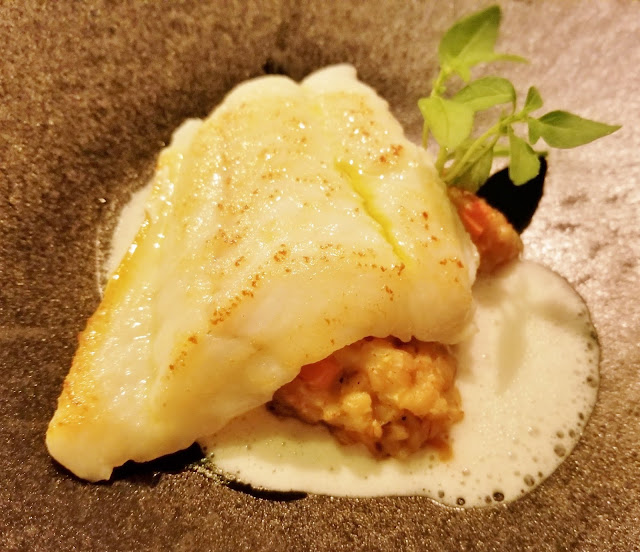Caromb is a small village located about 20 kms from Sablet between Mont Ventoux and the Dentelles de Montmirail. Caromb is memorable for me as the location of a restaurant called Le Four à Chaux where we and our Bistro des Copains team who were lodged in nearby Mormoiron dined the first night of a memorable trip to Provence back in January 2007.
 |
| Entrance to Caromb |
There are quite a few fountains in Caromb, many from the 18th and 19th centuries. The most well known is the Fountain du Portail du Rieu, on the main road in the village in front of the Medieval entry, and popular with the many cyclists who pedal by on their way to or from Mont Ventoux.
 |
| Center of Caromb |
Le 6 à Table is located in the center of Caromb across from the church. It is owned by chef Pascal Poulain and his wife Claire. The name comes from its location at 6 Place Nationale. As I mentioned at the beginning of the post, the first place we ever dined in Provence was called Le Four à Chaux. In an interesting coincidence, the restaurant where the chef first cooked was Le Four à Chaux which at the time was owned by his father.
 |
| Le 6 à Table Restaurant |
We arrived with friends Robert and Barbara of Vaison-la-Romaine culinary school Cuisine de Provence and shown to our table in the dining room. After catching up, we perused the wine list and were delighted to find a wine from Corinna Faravel's Domaine Martinelle on the list. In another bit of coincidence, wine from Martinelle appeared on Bistro Des Copains' wine list from time to time.
 |
| Domaine Martinelle Beaumes De Venise |
After we ordered wine, the chef sent out his amuse bouche for the evening, a little bite of Chèvre from Le Barroux with cherry tomato. An amuse bouche of some type, sometimes as simple as olives or tapenade almost always accompanies a meal in a French restaurant. The term literally means "mouth amuser" and serves to prepare guests for the meal and/or offer a preview of the chef's cooking style. I just posted on Facebook about my family's tie to Le Barroux. You might want to check it out.
 |
| Amuse Bouche of Chèvre from Le Barroux with cherry tomato |
What follows are photographs of a starter and main course and the desserts.
 |
| Starter of Provence asparagus with Salmon eggs and Sabayon sauce |
Shirley was happy to see a Spelt risotto accompanied the fillet of fish. Until we started spending time in Sablet, we had never encountered Spelt, an ancient grain cultivated on the plateau of Sault (1 hour from Sablet) and harvested in August. It was plentiful in the Roman era, it was only rediscovered by the general public about thirty years ago. You find it frequently on restaurant menus around Sablet. It has a sweet, nutty chewiness that we love.
 |
| Fillet of wild Barbue (species of fish in the Turbot family) with Spelt risotto |
 |
| Molten chocolate cake with strawberry sorbet |
 |
| Mille Feuille with strawberries and coconut ice cream |
We had a wonderful time at Le 6 à Table, a convivial evening with dear friends, excellent wine and delicious and beautifully presented food. I highly recommend you plan to dine here if you happen to be spending time in or around Sablet. You won't regret it.
Le 6 à Table
6 Place Nationale
84330 Caromb
Tel: +33 4 90 62 37 91
website: http://pascal-poulain.com/












